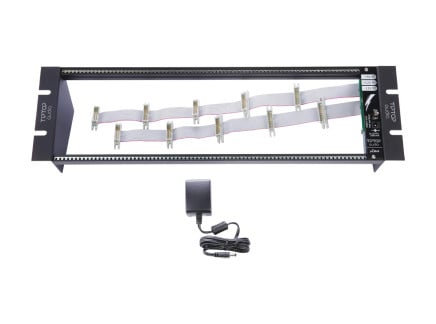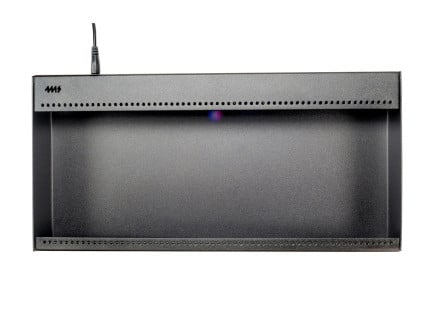Eurorack modular synthesizers are more popular than ever, and makers are continuing to produce groundbreaking and innovative modules that continue to blow our minds and challenge our expectations of what a synthesizer can do. But with all the technical considerations that go into getting started with modular, it's easy for the excitement about cool modules to turn into bewilderment at all the details. What does HP mean? How deep does my case need to be? Building a system means asking a lot of questions, some of which might not be obvious—so in this article, we're going to point out the most important things you need to know about Eurorack cases before getting started.
For some, simply having any enclosure is enough for their needs, and yet for others, the style of their case is just about as important as the modules themselves! So without further delay, let's talk about how to find the right balance of form and function.
The Practical Importance of a Eurorack Case
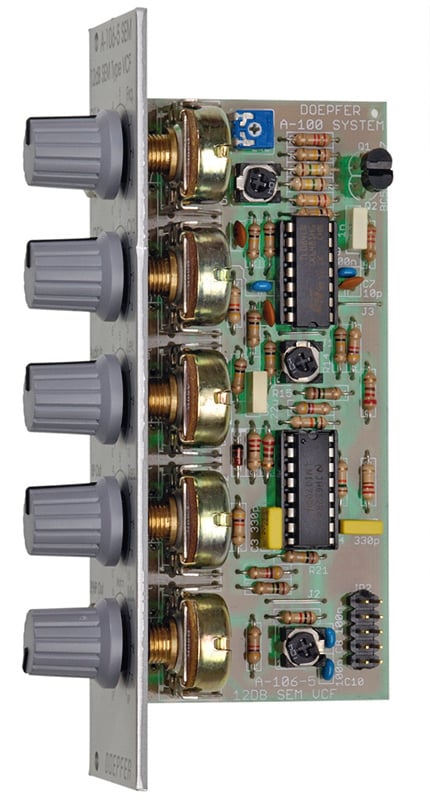 Profile shot of Doepfer's A-106-5 SEM Filter
Profile shot of Doepfer's A-106-5 SEM Filter
Why do we need a case for our Eurorack system anyways? While single modules could technically operate on their own with a compatible power connection, the real magic happens when several modules are used together, and a case provides the handy means of keeping them contained together in a single package. If your background experience involves effects pedals, modules within a case are not too dissimilar to a self-contained pedalboard. Of course, the largest difference is that pedals are usually routed into each other with a predetermined signal path, whereas modular patching is much more open-ended.
Aside from the convenience factor, most modules typically don't feature any kind of enclosure beyond the front panel, with PCBs, power supplies, and components otherwise bare. So to avoid any risk of component damage from impacts or electrical shorts from a stray piece of metal, keeping your modules in a case provides protection and peace of mind. This is an even more important concern if you plan on traveling with your system or bringing it out to live shows, as you wouldn't want debris or natural elements getting into the delicate bits of your precious modules.
Practicality aside, choosing a case for your Eurorack system is effectively like choosing a vessel for your creative voyages. It provides the framework in which you'll be able to explore new sonic ideas, and will house the collection of modules deemed necessary to realize your personal instrument, so picking something that feels right to you is, of course, very important.
Understanding the Essential Measurements and Dimensions
Even with all the variation in Eurorack module design and function, they are all typically compatible with each other, and conform to standards of size and power. We'll discuss Eurorack power considerations in future articles, but in researching and learning about cases it's key to recognize the terms and physical features common to every module in order to settle on the best case for you. If you're interested in technical details, Doepfer has an excellent page on their website detailing the construction details of the A-100 System, and thus the Eurorack modular format as a whole.
For starters, standard Eurorack modules are 3U in height, with U corresponding to standard 19" rack units of 1.75 inches. While the 3U height alone isn't what defines a Eurorack module, and other 3U modular formats existed prior to Dieter Doepfer releasing the A-100 System, having modules which correspond with an existing measurement standard can likely be a factor that contributed to Eurorack's rise in popularity. Cases like Tiptop Audio's Happy Ending Kit can be mounted in a standard 19" rack case, so provided you have at least 3U of space available, you could easily have a small suite of Eurorack modules alongside your audio interface or other pro-audio gear. Thus, it's common to see a multiple of three rack units as a shorthand for how many rows are in a case, such as 9U for three rows and 12U for four, even for cases that can't be installed in a rack.
Although height is consistent between Eurorack modules, width can vary greatly depending on the function of the module, being measured in units known as horizontal pitch, or HP for short. One HP is equal to 0.2" or 5.08mm, and corresponds with the hole spacing of the threaded strips that are sometimes used for mounting modules. 84HP happens to be the maximum usable space for modules that will fit within a 19" rack, and that size continues to be popular even for cases that are not rackmountable, but options are available at both smaller and wider widths, like 60HP and 104HP. Modules themselves can be as small as two HP or as wide as 84, and so keeping track of your case's maximum HP capacity will have a direct impact on how many modules can be mounted, depending on their individual widths.
 Comparing the depth of the Doepfer A-188-2 and 4ms Ensemble Oscillator
Comparing the depth of the Doepfer A-188-2 and 4ms Ensemble Oscillator
Height and width will usually be sufficient for most modular users, but as is often the case with life in three dimensions, it can be important to keep depth in mind as well. How deep a module is will totally depend on its design behind the panel, with things like the number of PCBs, the orientation of PCBs in relation to the front panel, and other factors resulting in a huge variation of depths. In more recent years, the migration from through-hole to components to smaller surface-mount designs has helped in substantially reducing the average Z-axis footprint of Eurorack modules, but it's still a vital measurement to remember when looking at older modules from the early days of Eurorack or some of the more complex digital modules from companies like Expert Sleepers.
Now as far as actually mounting modules goes, the rails within the case themselves tend to offer one of two ways to secure modules into the system: threaded strips and square sliding nuts. Functionally, they both accomplish the same task, but a threaded strip provides a uniform distribution of holes over the length of the rail to easily drop in and install a module at any position, provided there's room for it among other modules. Contrasting with this, the adjustable sliding nuts approach allows for modules to be neatly arranged with tight spacing, especially helpful in case you ever come across a super cool module that doesn't exactly conform with the measurement specs listed in the Doepfer document listed above, for one reason or another. (This is rare, but it does happen from time to time!)
Following the above, a minor thing to note with strips versus sliding nuts is that they often use different screw sizes for actually mounting modules. There are exceptions to this of course, but generally speaking M3 screws are used with threaded strips and M2.5 with sliding nuts, with the "M" denoting metric measurement followed by a diameter in millimeters. Most makers bundle M3 screws with their modules as a courtesy, while cases that contain sliding nuts will usually include a bag of M2.5 screws to help you change over.
A Tale of Two: 1U Tile Formats
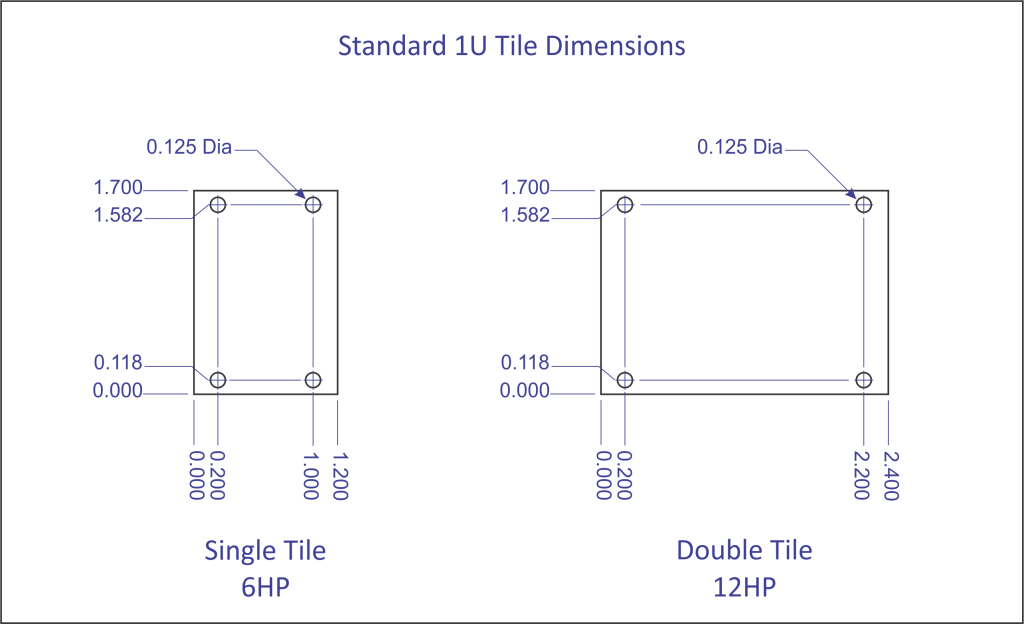 Pulp Logic's 1U Tile Specification
Pulp Logic's 1U Tile Specification
While 3U modules continue to be the star of the show in Eurorack, we've recently seen a rise in popularity of 1U modules, sometimes referred to as tiles. With their smaller profile, 1U modules tend to be a great way to supplement your system with additional utilities like mixers, attenuators, and external I/O interfacing—though now, manufacturers like Intellijel, Mosaic, and others provide everything from 1U oscillators and filters to effects processors and more.
However, one thing which might not be immediately obvious is that there are actually two 1U size standards in current production, and unfortunately, they're not cross-compatible. This can make things somewhat confusing to the uninitiated modular synthesist, especially given that both formats technically occupy the same amount of vertical rack space. Of course, if you plan on exploring 1U offerings, being aware of this as you're choosing a case (and especially so if you're building one) will have a direct impact on which modules will be available to you.
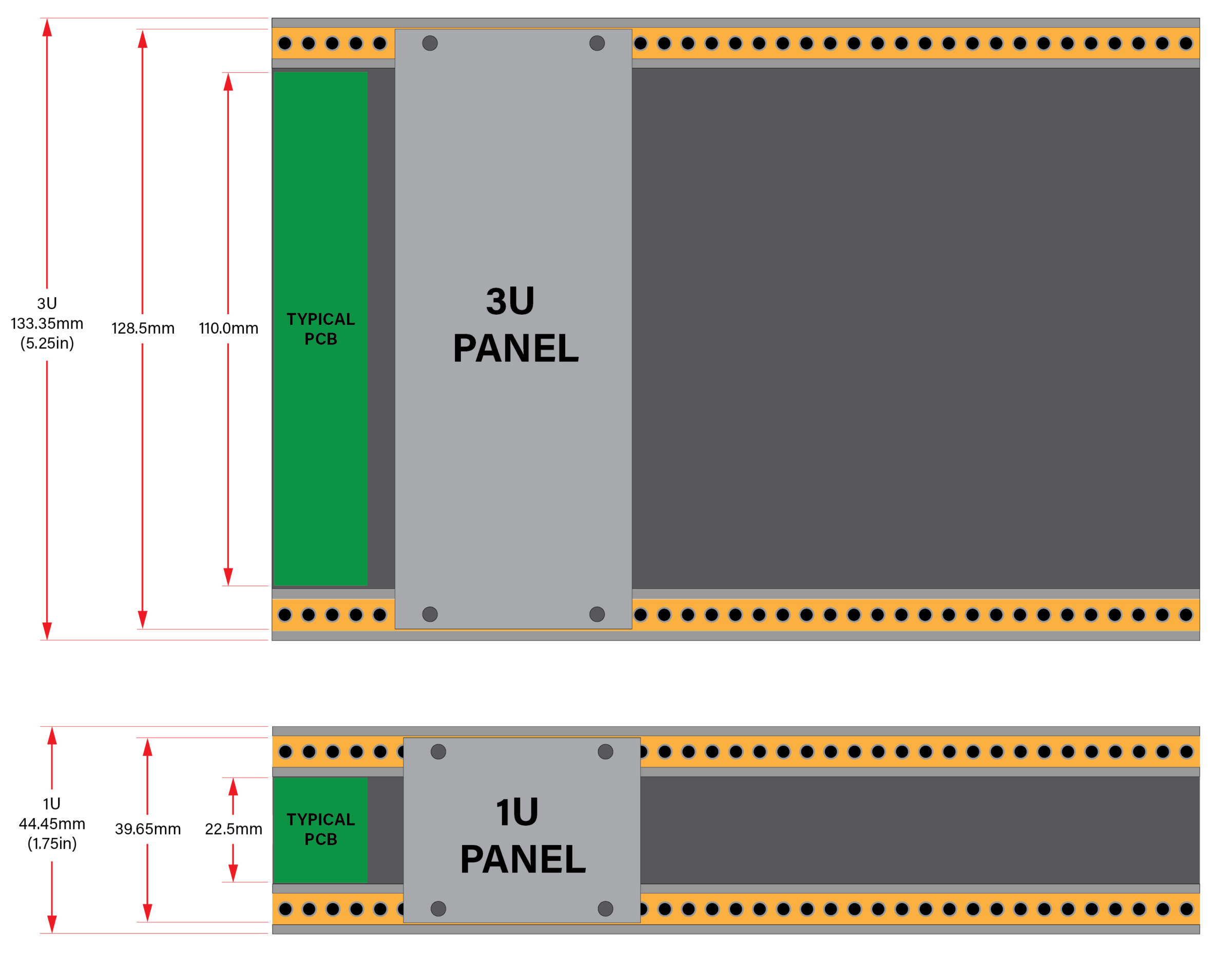 Intellijel's 1U Tile Specification
Intellijel's 1U Tile Specification
Pulp Logic defined their 1U "tile" standard first, basing their measurements upon the type of rails that are used in their cases, known as Vector rails. Unlike the rails used in some other cases, such as those from Doepfer and Tiptop Audio, Vector rails don't feature a lip on the outer edge to help guide placement of modules, and so without having to account for the physical space that the lip occupies, the panels of Pulp Logic format tiles are a bit taller and thus slightly closer to one rack unit themselves. Similar to the Happy Ending Kit, Pulp Logic offers the Mainframe, a set of 4U brackets for 19" racks consisting of 3U and 1U rails sharing a single pair of rack ears, but their series of Lunchbox cases have long been a favorite among those starting out or veteran patchers looking for a compact travel instrument.
Upon release of their own line of cases, Intellijel debuted their own line of 1U modules, sized slightly shorter than the earlier specifications defined by Pulp Logic. In this format, the lip of the rail is accounted for in the measurements, requiring the modules to be slightly shorter to still fit within a single rack unit. Given the success of Intellijel's Palette and Performance cases, it comes as no surprise that this 1U format has skyrocketed in popularity, but some makers like Mosaic, Ritual Electronics, and Shakmat play both sides and offer their modules with both panel sizes.
Qualitative Considerations for Cases

Before getting too caught up in the details of picking out the perfect case, it can be helpful to spend some time thinking about your artistic or functional goals for the collection of modules that it will contain. Will this be a large system primarily used in a studio for sound design and abstract musical composition? What about a fairly compact system to be used alongside drum machines and other hardware in the context of a live techno performance? Many actually find themselves with a case somewhere in between—large enough to develop full compositions and yet can still easily travel and be used for gigs.
Going into the process of buying a case with a solid idea of your intentions can offer valuable insight into features you might consider desirable. Not even just speaking in terms of technical things—for example, studio cases often don't include a lid in their design. This is totally fine for a stationary element at home, but safely bringing it out to a live show could prove to be tricky depending on its size. But if performing live isn't part of your modular plans, having a large case at home or in the studio for the most exploratory patching sessions is an effective option for many.
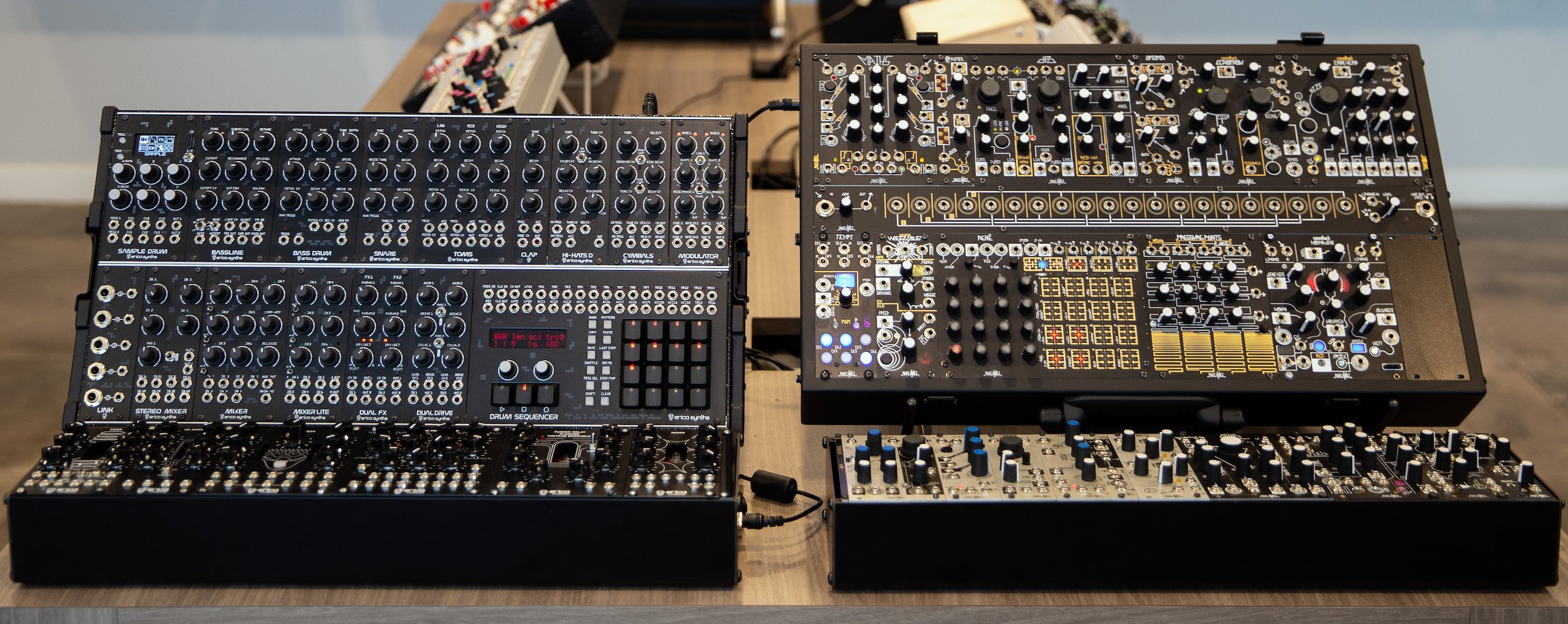
Generally speaking, the most popular cases tend to fall in the category of travel or performance cases. Packing up a collection of your favorite modules for a gig, studio session, or nightly jam with friends is a ton of fun, but a lot of these cases also happen to fit in the sweet spot of size, price, and utility that offers them a lot of appeal.
As more modules become available with dense feature sets and functionality, we've also seen more people adopting super compact and portable eurorack cases as part of their hardware setups. Historically there have been a number of options for simple single row cases, known as skiffs in Eurorack-speak, but in the past few years offerings like the Pods from 4ms or Intellijel's Palette cases have allowed cases to shrink down even further. It can be a fun musical exercise to trim your setup down to a case of this size, metaphorically slimming down from an orchestra or chamber group to a soloist or duo, depending on the choice of modules. And with more available solutions for MIDI-CV conversion and synchronization than ever, running a small modular friend alongside a drum machine or other instruments is totally feasible. Just keep in mind that with these smaller and often shallow cases, module depth can become a concern, so HP isn't the only thing to keep in mind when choosing modules for these tiny systems.
One other thing to consider is the material used for the case itself, something which has implications in both form and function. There's a wide range of different cases available today, most commonly made from wood, metal, or plastic. With proper construction and design, any of those materials will yield a highly reliable case that can withstand the rigors of travel and movement. In our experience wooden cases tend to be the heaviest, but if weight is not a factor and the specs of comparable cases are otherwise identical, leaning on your own aesthetic preferences is a totally valid way to go.
Quantitative Considerations for Cases
With goals in mind, it gets much easier to narrow in on the ideal case while evaluating the many available options. Understanding your own musical intentions enough to make an informed choice on what size of case will work best for you is key in picking something that will stick with you on your modular journey.
As mentioned above, portable performance or travel cases tend to be the most popular choice for many modular synthesists. Within that realm, 6U or 7U cases at 84 or 104 HP in width are pretty common—these sizes tend to be large enough to build up a substantive standalone instrument, while still being small enough to comfortably lug around town or board a flight as carry-on luggage (of course, be sure to check your specific airline's carry-on dimensions!). If performing and improvising fully modular compositions in a live context sounds interesting, a decent-sized travel case will go a long way in allowing you to build a system to your needs.
If bringing your system on the road isn't a concern, large studio style cases exist to serve as your synthesizer command center. Packed with juicy power, these behemoth cases keep all your modules in one place, ensuring you'll have everything you need to patch any sound at any given moment. Some standard options that range in size from modest to monstrous (pun intended) are available from Pittsburgh Modular and Doepfer, but if you require a studio case that can only be described as truly magnificent, our good friends at Needham Woodworks craft incredibly beautiful cabinets with a striking presence.

Perhaps you can't decide how big you'd like your case to be—thankfully there exist options for expandable cases! Frap Tools offer their PLUS Cases in units of 42hp cases, available individually or in expansion packs of two and four. But even larger cases like the Intellijel Performance Cases and Tiptop's Mantis support dedicated joiners and brackets to facilitate joining two together. Even the highly compact 4ms Pods can be daisy-chained from a single power brick, so loading up one or two of your favorite modules in each is a fun way to make Eurorack even more modular!
A Brief Note About DIY Eurorack Cases
Eurorack cases can be expensive, and the cost of just an enclosure without any modules (especially if it includes a power supply) is a formidable entry barrier for many. However, with some spare time, resourcefulness, and a dash of creativity, DIY case options can help make a modular system a tad more attainable, and immensely more personalized and unique to you!
 My first Eurorack case, built into a toolbox carrying case
My first Eurorack case, built into a toolbox carrying case
Of course, if you have the tools and skills to craft a case from wood or some other material, there's something especially rewarding about building your own instrument from scratch. But seeking out an existing object to be repurposed as your case could also be an exciting (and sustainable) journey. We've seen old briefcases, tool chests, wooden boxes, and all kinds of other things get used as the basis for a modular system. In a pinch, you could even build a cardboard eurorack case until a sturdier enclosure comes along or upgrade to a pre-built offering.
Once you've chosen a suitable home for your system, the next logical step would then be to install the necessary hardware to begin mounting modules. Thankfully, companies like Tiptop Audio and Eskatonic Modular offer rails in standard HP sizes as well as other parts like brackets and rack ears to securely house your modules.
Just as there are an abundance of options in choosing the perfect collection of modules for your artistic vision, there are now plenty of choices for Eurorack cases to help bring those ideas to life. But whether you're looking to have all your studio tools available to you at once or curating a hyper-focused and minimal setup for compact travel, picking the right case is key to accomplishing your creative goals. With all that said, between the presented specifications and terms along with some thought process considerations, this article should leave you well equipped to venture forth and hone in on the ideal case solution for you.


